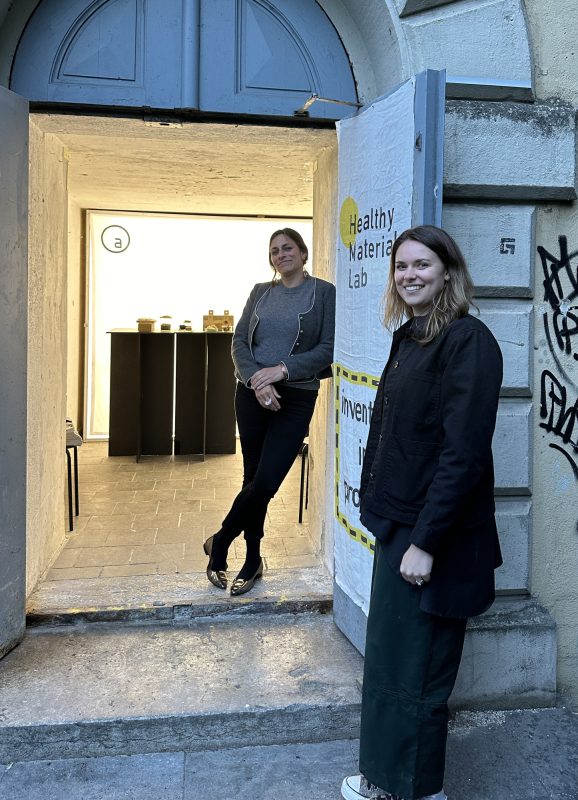A reflection on HML’s participation in “How to co-create with nature” at MCBW 2024.
HML delivered three virtual presentations over a week in May. The presentations addressed three aspects of the work of HML: Healthier Affordable Building Materials, A HempLime Case Study, and Collaborating with Natural Systems for Regenerative Materials. HML also showcased products from our mobile library at an in-person exhibition at the Architekturgalerie München.
To get an insider look, we interviewed Leila Behjat, HML Director of Materials Ecology, who was representing the Lab in person. Leila also leads the HML’s new European Bureau.
The theme of the event was “How to Co-Create with Nature.” What does this mean to you?
To me, this means a rethinking of design practice. I strive to approach a project holistically —thinking it through from its beginning to its end. This includes the origin of the material, the quality of the soil it might have grown in, a consideration for how much can be used, and understanding who I am partnering with in nature - an aspect our colleague Jess Thies also stresses in her presentation on Natural Systems for Regenerative Materials.
We need to rethink our design requirements based on nature’s capabilities. The things we build require care. Today, we only care for something if it malfunctions or needs repair, and repair is typically something we try to avoid. However, things that require less care (like petrochemical based materials) are often materials that are harmful to us.
What was your overall highlight of the experience?
This was our (HML) first year participating in MCBW. Our experience brought insights and successes. The three virtual events allowed us to share deep dives into topics around material health, designing and building with nature; and the in-person exhibit provided a hands-on experience around healthy products that are scaled and available today. There was a spirit of collaboration throughout with colleagues, a shared sense of curiosity; people we met were open to discovering new ideas and topics. Additionally, since the event was spread throughout sites in the city of Munich, these ideas became available and accessible in multiple settings and contexts.

MCBW events were dispersed throughout the city.
What are your key takeaways?
It is vital we continue to discuss and observe how healthy products can, will, and must create healthy cities. The materials we choose affect more than their immediate environment such as our own home - they have a large impact on surrounding communities. And the materials surrounding us are impacted by factors of climate change such as heat and humidity. I am reminded of our past research insights here on the intersection of Climate, Chemicals + Human Health.
Also, it was encouraging to see that people are interested in learning more about scalable products from fungi and mycelium!
Can you tell our audience about the new mobile library?
Donghia healthier Materials Library is a valuable resource, displaying and offering hands-on access to both healthier and healthy products and the raw materials they come from. The collections prioritize material health thinking and the core question we ask: “What is it made of?” We want to translate the same experience of our in-person library located in New York City, into a mobile format for those based elsewhere. It’s a teaching tool that combines the aesthetics of an exhibition with material health thinking. By taking this hands-on, holistic approach to our mobile exhibitions, we can support more colleagues as they engage with materials and bring this thinking into their practice applications. And it helps transfer the fact that there are great products, healthier and healthiest out on the market, scaled and ready to be specified.

HML Mobile Library exhibition in Munich.
Can you share more about the New European Bauhaus?
We are an official partner of the New European Bauhaus, an initiative of all EU members within the European Union, which aims to push forward the EU Green Deal with high attention on the built environment. We align with their ideals of “beautiful, sustainable and inclusive”, making all spaces accessible and healthy.
We have exhibited in Munich, Frankfurt and Brussels this year, bringing HML’s Material Health thinking to the EU market. As our work crosses two continents, we are a bridge to overcoming barriers and siloed work. We can cross-pollinate insights and inspire the emergence of healthy materials happening in both places.
Sometimes this means carrying materials in our suitcases!
Thanks for these insights Leila!
More updates from the EU to come soon! Meanwhile, if you are looking for EU specific products, look for the EU Icon on our Material Collections.

Leila Behjat and Jess Thies of HML exhibiting at Munich Creative Business Week in the Architekturgalerie Munich.
Read More
Join Our Academic Network
Get Access to our carefully researched and curated academic resources, including model syllabi and webinars. An email from an academic institution or a .edu email address is required. If your academic institution does not use .edu email addresses but you would like to join the network, please contact healthymaterialslab@newschool.edu.
Already have an account? Log in